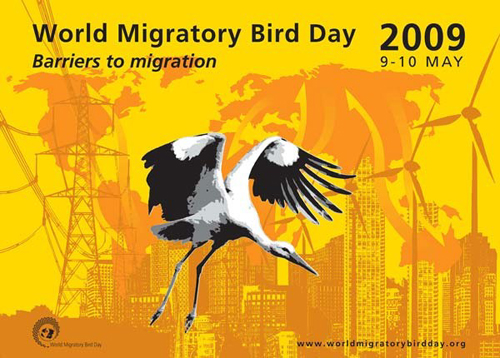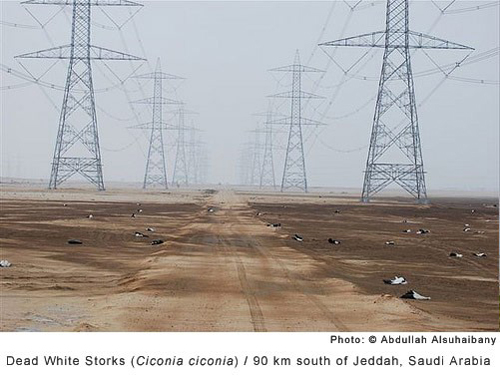WORLD MIGRATORY BIRD DAY 2009
"Barriers to migration"
9-10 May 2009
Millions of birds killed worldwide by man-made barriers each year




Bonn/Nairobi, 8 May 2009 – This upcoming weekend (9-10 May 2009), thousands of people around the world will be taking part in World Migratory Bird Day (WMBD) events to draw attention to the many man-made obstacles birds face during their migration.
The central theme for this year’s World Migratory Bird Day - “BARRIERS TO MIGRATION” – aims to highlight the effects man-made structures such as wind turbines, communication masts, tall buildings and windows, power lines and fences have on migratory birds.
During migration birds face a number of natural obstacles such as expanding deserts, seas, huge mountains and other natural barriers. Yet, next to these natural barriers, birds are increasingly being confronted with man-made barriers on their journeys.
These man-made structures can not only disturb the migratory movements of birds, but it is estimated that bird-strike due to collisions with man-made structures is responsible for the deaths of many millions of birds worldwide each year.
Among the affected bird species are abundant as well as rare and endangered species. Man-made barriers are believed to be a growing threat and are likely to be a significant contributor to the decline in many populations, especially those of scarcer, more vulnerable bird species.
“Hundreds and thousands of migratory birds, including many that are protected under international wildlife treaties such as the African-Eurasian Migratory Waterbird Agreement (AEWA), are killed in growing numbers by man-made barriers. Some of these cases could quite easily be avoided by introducing technical measures for reducing this often avoidable cause of destruction” said Bert Lenten, Executive Secretary of AEWA and initiator of the World Migratory Bird Day campaign.
However, each year the number of wind turbines, power lines, skyscraping radio, TV and cell phone transmission masts, reflecting plate glass windows, tall buildings and other structures continues to grow, often without consideration of avoidance and mitigation measures known to reduce avian mortality through collisions with these structures.
In addition to a number of known mitigation measures specific to each type of structure, particularly the location and placement of structures such as wind farms and power lines along major migratory routes or near areas regularly used by large numbers of feeding, breeding or roosting birds, can dramatically affect the likelihood of collisions. Placement of structures along important wetlands, river valleys and in coastal areas where large numbers of migratory birds congregate, are also likely to increase the risk to migratory birds.
“Although man-made barriers represent an increasing problem for migratory birds worldwide, so far little attention has been given to possible solutions. My strong hope is that World Migratory Bird Day will help raise awareness of these barriers and that action will be taken to reduce the impact of some of these man-made structures on migratory birds” said Bert Lenten.
Dedicated people and organisations around the world will be using World Migratory Bird Day (WMBD) this upcoming weekend to conduct events, which will help draw attention to the impact of man-made barriers on migratory birds. Over one hundred separate events in 44 countries have already been registered on the WMBD website so far:
www.worldmigratorybirdday.org
World Migratory Bird Day (WMBD)
World Migratory Bird Day (WMBD) is a global initiative devoted to celebrating migratory birds and for promoting their conservation worldwide. This year WMBD will take place on the weekend of 9-10 May and its central theme will be ‘Barriers to migration.’
World Migratory Bird Day is being organised by the African-Eurasian Migratory Waterbird Agreement (AEWA) and the Convention on Migratory Species (CMS) – two international wildlife treaties administered by the United Nations Environment Programme (UNEP) and other partners.
People and dedicated organisations around the world will be using the event to draw attention to man-made barriers and their impact on migratory birds. Over one hundred separate events in 44 countries have already been registered on the WMBD website so far (see:
www.worldmigratorybirdday.org). Activities to mark WMBD include bird festivals and bird watching trips, public discussions, exhibitions, presentations, bird rallies and other educational and public events.
For more information please see:
www.worldmigratorybirdday.org
Barriers to migration (background on this year’s WMBD theme)
Windows and tall buildings
Windows of all sizes and types, even small and narrow windows, from those found on tall buildings to those used in residential houses are very dangerous for birds. Ornithologists usually call them “invisible killers” due to the large number of deaths and injuries they cause regardless of species, age, sex and the conditions in which collisions occur. Attracted by the reflection of trees or plants located near the windows, birds try to pass through them, sometimes, at top speed. This can lead to fatal or other injuries or simply exhaustion as they attempt to overcome the invisible barrier and end up falling to the ground and thus becoming easy prey. Predators such as cats often lie in wait for their victims to quickly remove them. Moreover, some studies show that about half of those birds, which manage to fly away, die later due to injuries received. These facts are often unknown to those observing bird strikes, as they tend to think collisions do not actually harm birds and that they are able to fly away without any lasting damage.
Wind turbines
Although wind turbines are a form of clean technology for renewable energy production and therefore an important tool in combating climate change, they also represent a danger to migratory birds. Wind turbines, especially when standing isolated in large-scale wind farm developments, also represent a severe potential hazard for migratory birds. Their blades rotate at speeds of up to 200 kilometres per hour and, when placed along the major migratory routes of birds, wind turbines can become extremely dangerous obstacles causing both injuries and fatalities to many species of migratory birds. In addition to causing collisions, wind turbines are also known to cause displacement of migratory birds and are considered especially detrimental in areas where there is a known high concentration of migratory birds, for example at major stop-over and feeding sites. Like other obstacles that are surrounded with lights for air traffic safety, wind turbines equipped with bright lights can also attract disorientated birds and lead to fatal injuries during the night.
Wind farms are often built along coastlines and mountaintops, usually in areas that have high wind potential, and which often lie along the flight paths of many migratory birds. Unfortunately, wind farms are still being built along coastlines, mountain ridges and wetlands, sometimes without any prior assessment of their potential environmental impact on migratory birds and in places where there is a known high concentration of many migratory bird species. It is especially a cause for concern when wind farms are constructed in areas that are frequently used by endangered and rare bird species.
Power lines
Power lines and fences are believed to pose a particular risk to migratory birds. Overhead power lines stretch for millions of kilometres globally and the resulting carpet of surface cables continues to increase. Apart from the risk of electrocution faced by birds, which results from poorly designed power poles, the cables themselves constitute objects for potential collisions. Fast-flying birds, so-called poor fliers due to their small wings, and birds lacking in agility are especially at risk; they tend to hit conductors and ground wires, frequently at night and in poor weather conditions.
Communication towers and masts
Communication towers and masts are commonly high structures located on elevated points of land and their supporting guy wires are extremely dangerous for migratory birds. Fast flying birds simply do not notice loose wires and birds that are not very agile have difficulties avoiding them. Stormy nights and bad visibility make supporting wires even more dangerous for birds and dramatically increase the risk of collision. Brightly lit towers in the similar adverse conditions make bird-strikes even more likely. Birds, especially nocturnal birds travelling in weather conditions like fog or mist, loose their navigation cues and get disoriented or dazzled by the lights of towers. Mistaking them for constellations, birds tend to circle around the lights and rarely escape fatal hits against the wires and other supporting elements. Even if they manage to avoid heavy strikes, birds are often badly injured or they waste energy they need to accomplish their migration journey.
Burdening factors
When wind turbines, power lines and other man-made structures are placed in areas where the density of birds is high or along major migratory paths, the probability of collisions significantly increases. In particular, the placement of windfarms and other structures along landscape features such as river valleys and coastal areas, used by migratory birds as navigation cues, is believed to significantly increase collisions. Collision risks are also increased or diminished by the intensity and use of lighting and size – the more lighting in place and the taller the structure is, the more dangerous the objects are for birds. Bad weather and darkness, as well as the physical characteristics of birds (acuteness of vision) or flight behaviour (flocks), also influence the collision rate.


